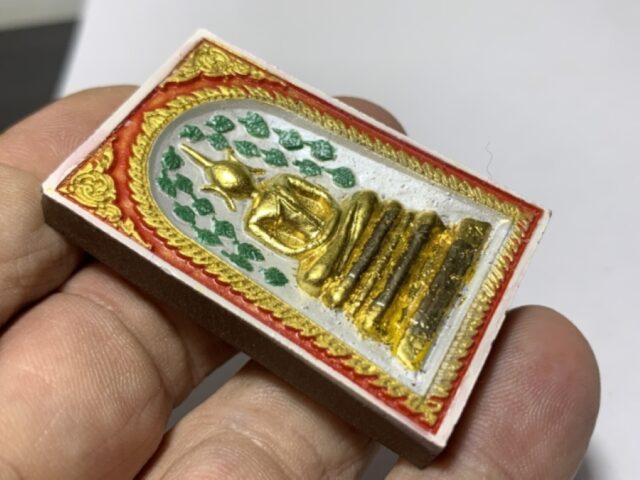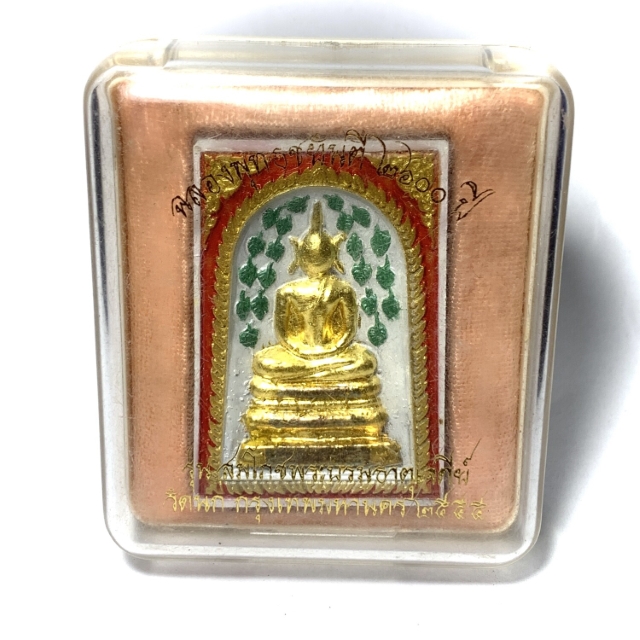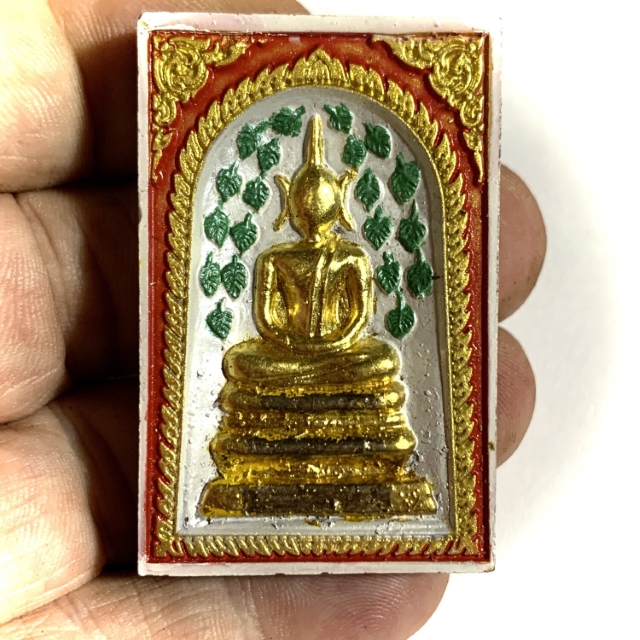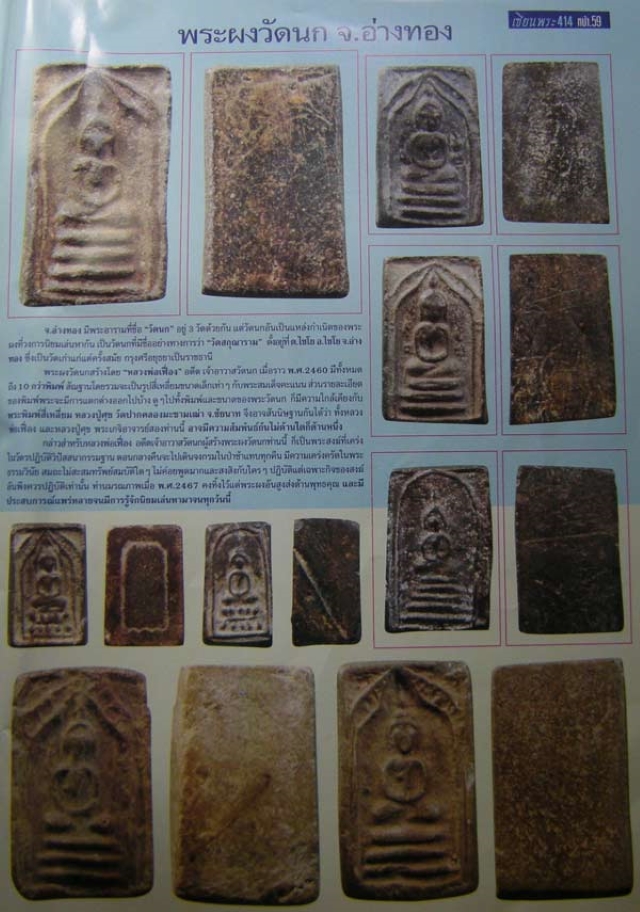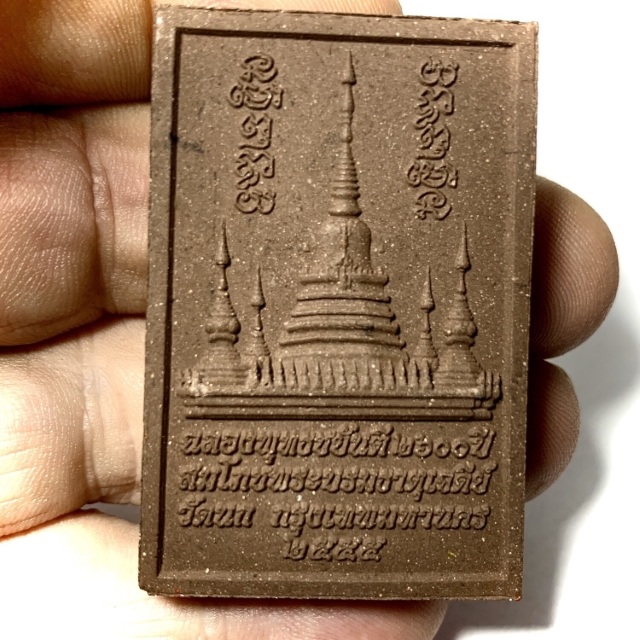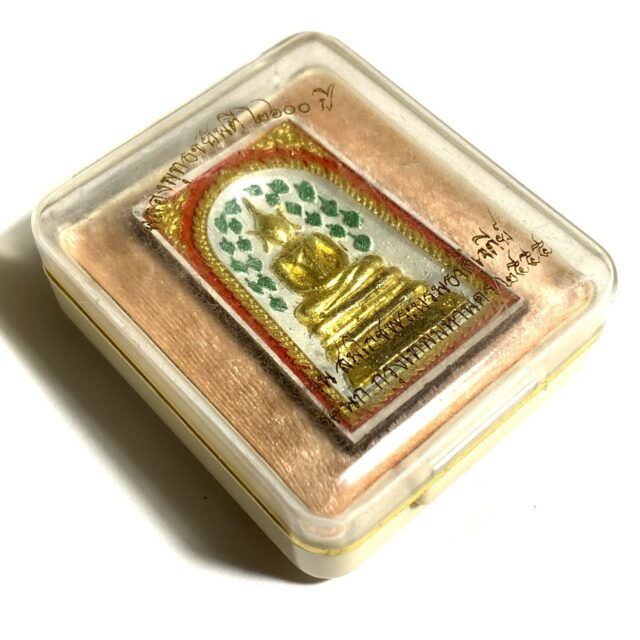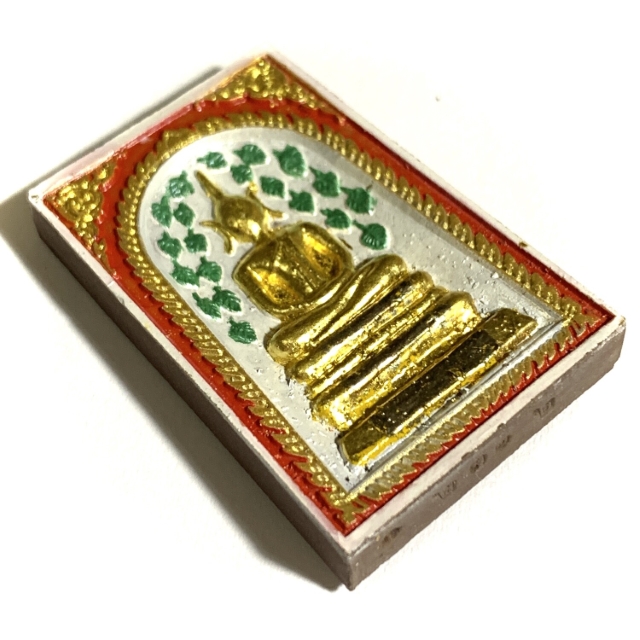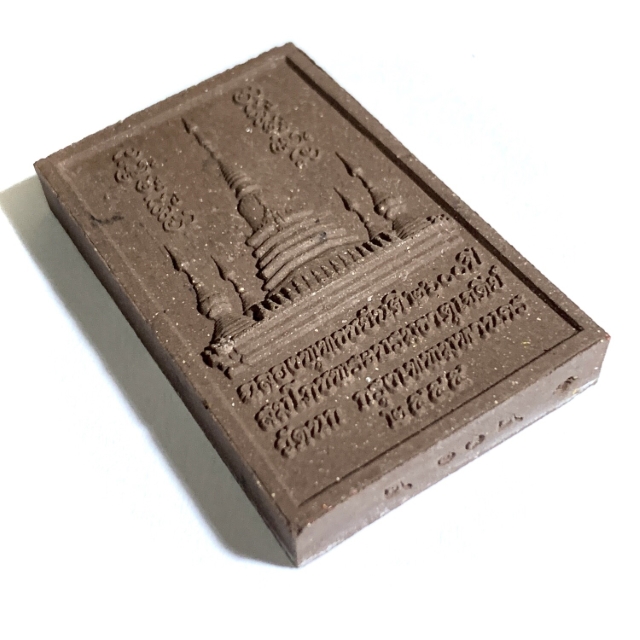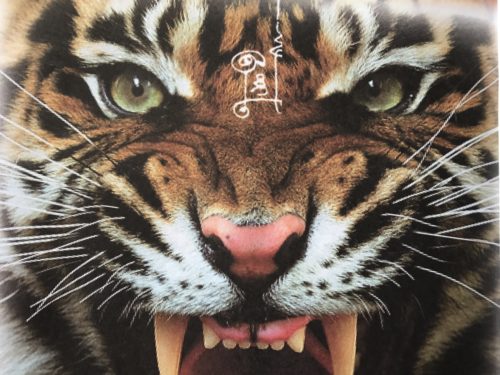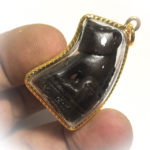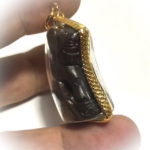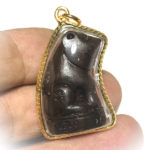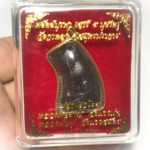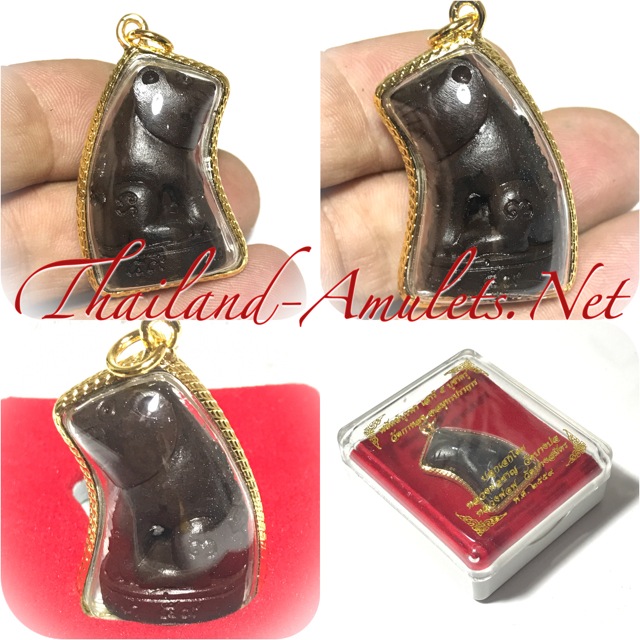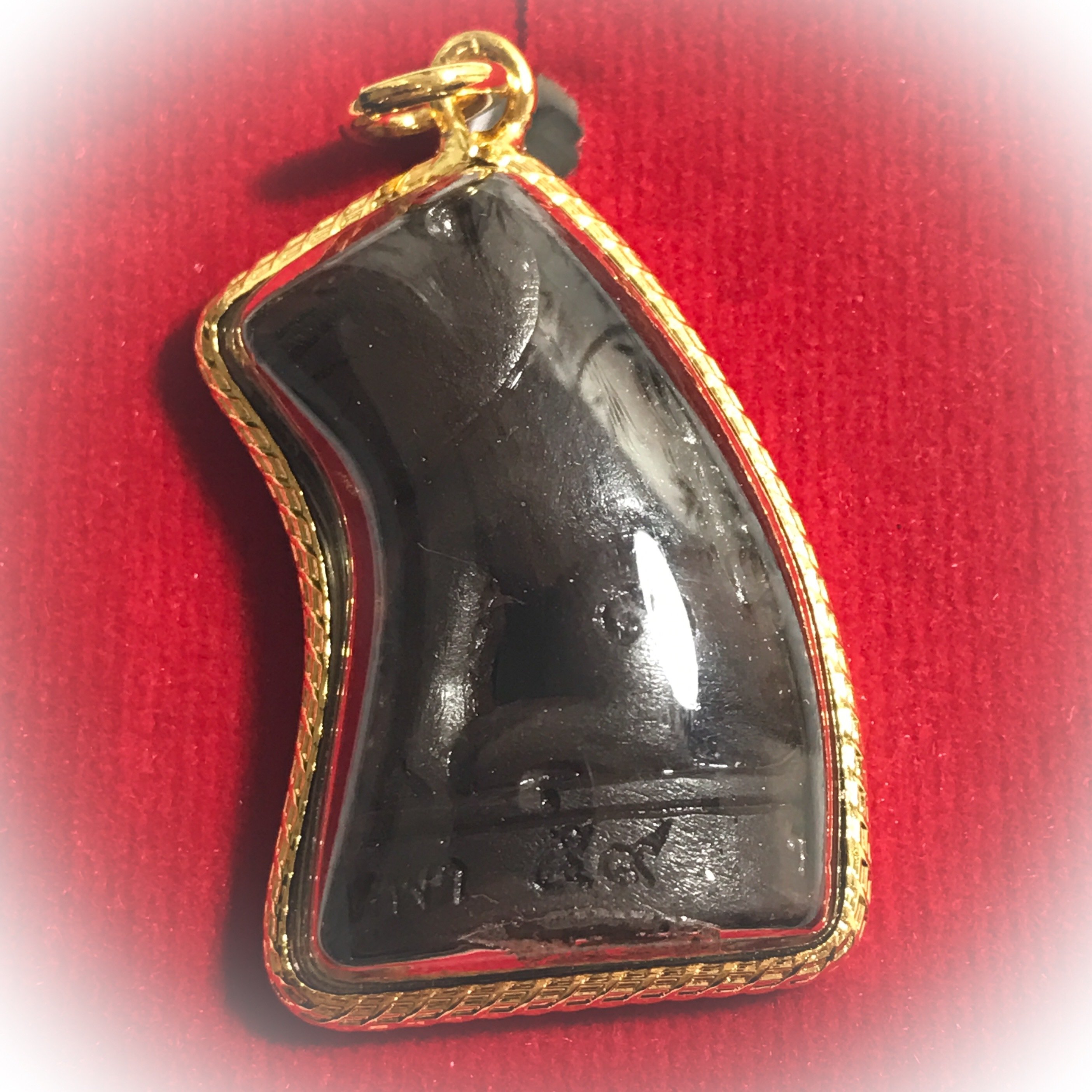Hun Payont Mern Mahaa Choke (Master Version)
Hun Payont Mern Mahaa Choke—literally translated as the “Re-animated Golem Effigy of 10,000 Lucky Windfalls”—is a sacred talisman designed to bring luck, protection, and defense against dark magic. In Western terms, it can be understood as a spiritually empowered guardian effigy that channels fortune and safeguards its owner. This talisman was created by Luang Pu Nen Kaew Kamphiro of Wat Ban Kaset Thung Setthi, Phon Thong District, Roi Et Province. It is recognized as one of the most powerful protective amulets in Thai Buddhist tradition.
The original Hun Payont was crafted in 2008. When first offered to devotees, the talisman quickly became highly sought after, and all pieces were claimed within a very short time, making it extremely rare today.
In 2011, on the auspicious annual day of Luang Pu Nen Kaew, he conducted the sacred Wai Kroo ceremony to honor spiritual teachers on Saturday, March 26. During this ceremony, he consecrated the top of the stupa and celebrated the Golden Stupa of the Deity of Wealth. On this occasion, Luang Pu Nen Kaew created a new batch of amulets for devotees, including the Hun Payont Mern Mahaa Choke (Master Version). This version was intentionally designed to be larger, suitable for display in homes, vehicles, or on desks.

The legend behind the Hun Payont Mern Mahaa Choke originates with “Mern Han,” a warrior who served as a military officer. He was highly skilled in magical incantations and possessed extraordinary physical strength, reportedly strong enough to defeat a wild water buffalo with his bare hands.

The talisman was cast from leftover materials of the first-generation Hun Payont, combined with newly inscribed sacred metal sheets (yantras), and consecrated over three years. Its spiritual potency is enhanced by the blessings of Luang Pu Nen Kaew and his spiritual teachers. Through ritual consecration, prayers, and mantras, this effigy was imbued with spirit and consciousness, granting protection, fortune, and safe travels to its owner. It safeguards property, repels malevolent forces and black magic, and even shields livestock and valuables from theft or harm.

Incantation to Activate Hun Payont Mern Mahaa Choke:
“Om Na Ma Pa Ta Je Ta Poo To Maha Poo Tang Hun Payont Tang Nimit Tang Kang Rup Pin Yang Ma Ma Ehi Ehi Na Mo Puttaa Ya”
(Recite 7 times)

Protective Powers
The Hun Payont Mern Mahaa Choke is renowned for its exceptional protective capabilities:
- Physical Protection: Creates an invisible shield against physical harm, accidents, and dangers
- Spiritual Defense: Repels malevolent spirits, black magic, curses, and negative energies
- Property Security: Safeguards homes, vehicles, and valuables from theft or damage
- Danger Avoidance: Grants the intuitive ability to sense and avoid potential threats
- Livestock Protection: Extends protective influence to animals and livestock owned by the keeper
These protective qualities operate through what Thai occultists call “Dtua Kroo” (ตัวครู) or “teacher entity”—a conscious spiritual force that actively intervenes to prevent harm. Unlike passive amulets that merely deflect negative energies, the Hun Payont is believed to possess agency and intelligence, allowing it to anticipate dangers and take preemptive action.

Prosperity Enhancement
Beyond protection, the Hun Payont Mern Mahaa Choke is especially valued for its ability to attract prosperity and good fortune:
- Wealth Attraction: Draws financial opportunities and unexpected windfalls
- Business Success: Increases customer traffic and favorable business transactions
- Career Advancement: Removes obstacles to professional progress and promotion
- Resource Multiplication: Helps existing resources grow and multiply
- Gambling Luck: Enhances fortune in games of chance (though many masters caution against this use)

The prosperity-bringing aspects of the Hun Payont are linked to its connection with the “Deity of Wealth” (เทพเจ้าแห่งความมั่งคั่ง), whose energy was incorporated during the 2011 consecration ceremony at the Golden Stupa. This connection enables the Hun Payont to function as a spiritual magnet for prosperity, drawing beneficial opportunities toward its owner.
Social Influence and Relationships
A third category of benefits associated with Hun Payont Mern Mahaa Choke involves enhanced social standing and interpersonal relationships:
- Metta Mahaniyom: Increases personal charm, likability, and positive first impressions
- Authority Enhancement: Strengthens leadership presence and command respect
- Conflict Resolution: Helps defuse tensions and resolve disagreements favorably
- Speech Power: Enhances persuasiveness and the impact of one’s words
- Relationship Harmony: Promotes peaceful and supportive relationships with family and associates
These social benefits stem from the Hun Payont’s ability to subtly influence the perceptions of others, creating an aura of trustworthiness and authority around its owner. This aspect is particularly valued by those in leadership positions or whose work requires frequent negotiation and persuasion.

Hun Payont Mern Mahaa Choke LP Naen Ongk Kroo in Nam Man Prai Oil with 2 Takrut
Ritual Activation and Maintenance
Initial Activation Ceremony
When acquiring a Hun Payont Mern Mahaa Choke, proper ritual activation is essential to establish a personal connection with the effigy. The recommended process includes:
- Purification: Cleansing oneself through bathing with sacred herbs before handling
- Offering Preparation: Arranging traditional offerings including flowers, incense, candles, fruits, and betel nut
- Sacred Space: Creating a dedicated space facing an auspicious direction (typically East)
- Incantation Recitation: Chanting the specific activation mantra provided by Luang Pu Nen Kaew
The core activation incantation for Hun Payont Mern Mahaa Choke is: “Om Na Ma Pa Ta Je Ta Poo To Maha Poo Tang Hun Payont Tang Nimit Tang Kang Rup Pin Yang Ma Ma Ehi Ehi Na Mo Puttaa Ya”
This mantra should be recited seven times while focusing intention on establishing a spiritual bond with the Hun Payont. The number seven holds particular significance in Thai occultism, representing completeness and the seven energy centers of the body.
Ongoing Maintenance and Offerings
To maintain and strengthen the Hun Payont’s powers, regular attention and offerings are recommended:
- Weekly Offerings: Providing fresh flowers, incense, and candles every seventh day
- Monthly Empowerment: Reciting the activation mantra on each full moon
- Annual Ceremony: Conducting a more elaborate offering ceremony on the anniversary of acquisition
- Special Occasions: Additional offerings after receiving significant benefits or protection
Traditional offerings include red flowers (particularly Dok Khem or ดอกเข็ม), sweet fruits, betel nut, and special incense containing herbs associated with prosperity. Some devotees also offer small amounts of alcoholic spirits, though this practice varies depending on regional traditions.
Proper Housing and Display
The physical placement and housing of the Hun Payont significantly impact its effectiveness:
- Elevated Position: The Hun Payont should be placed at or above eye level
- Directional Orientation: Typically facing the main entrance for maximum protective effect
- Clean Environment: The surrounding area should be kept clean and respectful
- Appropriate Shrine: A dedicated small shrine or display cabinet is recommended
- Separation from Lower Objects: Should not be placed near or below mundane items
For the larger Master Version created in 2011, placement in the main living area, office, or shop entrance maximizes its protective field. Some practitioners recommend periodic exposure to moonlight (particularly during full moons) to “recharge” the Hun Payont’s energies.
Spiritual and Ethical Considerations
Relationship with Buddhism
While Hun Payont practices incorporate elements that might seem separate from orthodox Buddhism, Thai practitioners view them as complementary rather than contradictory to Buddhist principles. The creation and use of Hun Payont exist within a framework where:
- The ultimate goal remains spiritual development and eventual liberation
- Protective magic serves as skillful means (upaya) to address worldly obstacles to practice
- Compassionate intention remains central to proper use
- Respect for the Triple Gems (Buddha, Dharma, Sangha) forms the foundation of practice
Luang Pu Nen Kaew Kamphiro, like many Thai Buddhist masters, integrates traditional protective magic within a fundamentally Buddhist worldview. The Hun Payont is thus seen not as an end in itself but as a supportive tool for navigating life’s challenges while pursuing spiritual development.
Ethical Usage Guidelines
The proper use of Hun Payont comes with specific ethical guidelines:
- Benevolent Intention: The Hun Payont should be used for protection and legitimate prosperity, not to harm others
- Respectful Treatment: The effigy must be treated with reverence as a sacred object
- Sharing of Merit: Benefits received should be partially dedicated to all beings
- Gratitude: Acknowledging protection and assistance received builds stronger connection
- Moral Conduct: Maintaining ethical behavior enhances the Hun Payont’s effectiveness
Practitioners are cautioned that using the Hun Payont for harmful purposes or treating it disrespectfully can lead to diminished effectiveness or even negative consequences. The relationship between owner and Hun Payont is viewed as reciprocal—care and respect are rewarded with protection and assistance.
Authentication and Valuation
Identifying Authentic Hun Payont
Given the high demand for Hun Payont Mern Mahaa Choke, distinguishing authentic pieces from imitations is crucial. Authentic examples typically feature:
- Official Temple Seals: Markings from Wat Ban Kaset Thung Setthi
- Consecration Materials: Visible sacred powders and materials in the composition
- Energetic Presence: A palpable sense of energy often reported by sensitive individuals
- Documentation: Certificate of authenticity with temple stamps
- Specific Artistic Elements: Characteristic stylistic features consistent with Luang Pu Nen Kaew’s creations
Serious collectors often seek verification from recognized experts in Thai amulets or directly from representatives of Wat Ban Kaset Thung Setthi. The temple maintains records of official releases and can sometimes verify authenticity of specific pieces.

Factors Affecting Value
The value of Hun Payont Mern Mahaa Choke is determined by several factors:
- Edition: First-generation (2008) pieces command significantly higher prices than later editions
- Consecration Level: Items that underwent additional blessing ceremonies hold greater value
- Condition: Pristine condition with no damage increases desirability
- Provenance: Clear documentation of the item’s history and acquisition
- Reported Efficacy: Pieces associated with specific miraculous events may be more valued
- Materials: Special editions containing rare or precious materials command premium prices
As with many sacred objects, the spiritual value to practitioners often transcends monetary considerations. Many devotees refuse to sell their Hun Payont regardless of offered price, believing the spiritual bond and protection to be irreplaceable.
Contemporary Relevance and Global Interest
Adaptation to Modern Life
While rooted in ancient traditions, Hun Payont practices continue to evolve to address contemporary challenges:
- Business Protection: Used to safeguard modern businesses from economic downturns
- Digital Security: Some practitioners report protection extending to digital assets and online ventures
- Travel Safety: Specially designed Hun Payont for vehicle protection during long journeys
- Urban Applications: Adapted rituals for apartment dwellers and office environments
- International Adaptations: Modified practices for devotees living outside Thailand


